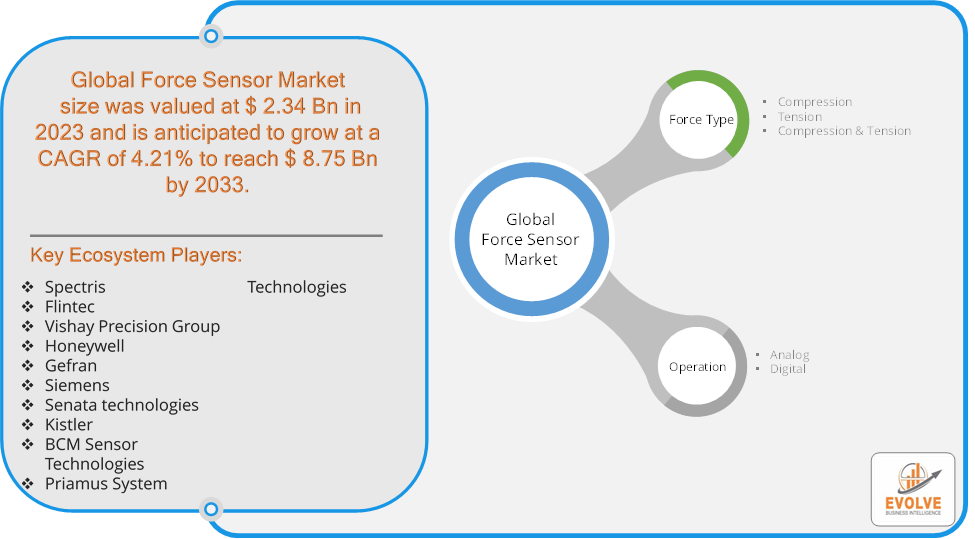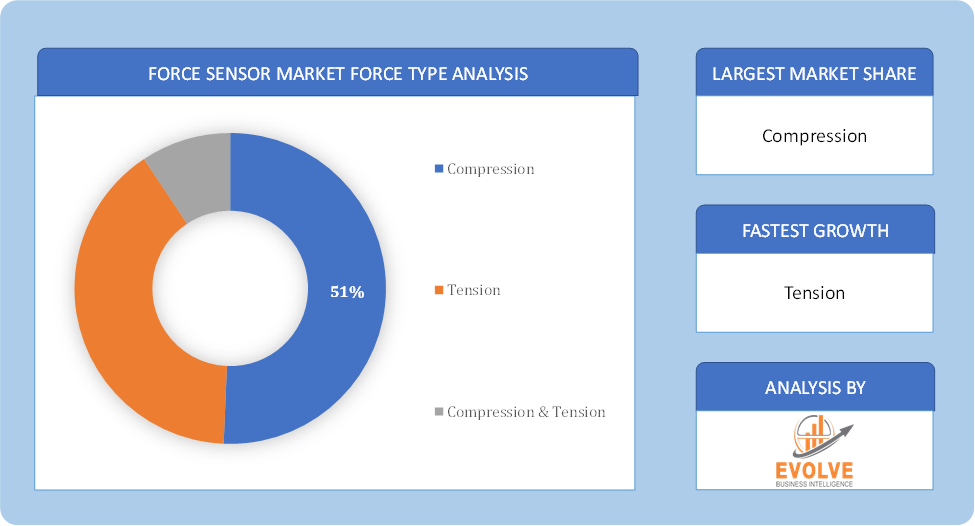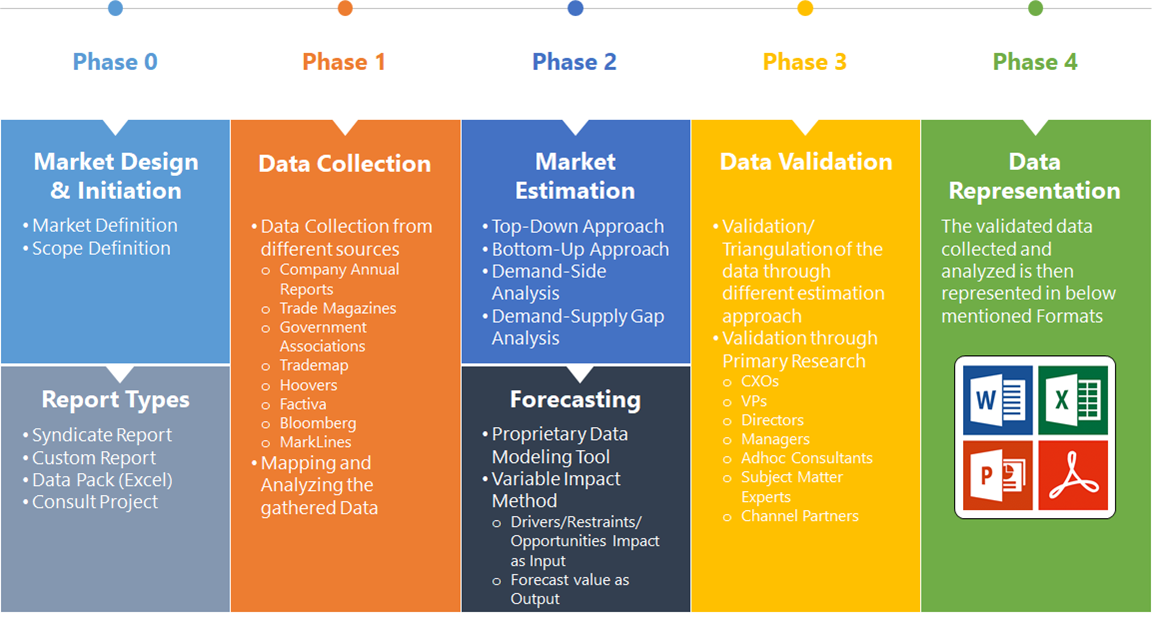Force Sensor Market Overview
The Force Sensor Market Size is expected to reach USD 8.75 Billion by 2033. The Force Sensor Market industry size accounted for USD 2.34 Billion in 2023 and is expected to expand at a compound annual growth rate (CAGR) of 4.21% from 2023 to 2033. The Force Sensor Market refers to the global industry involved in the development, production, and sales of force sensors. These sensors are devices that measure the amount of force applied to an object and convert this measurement into a readable output, typically in the form of electrical signals.
The market encompasses various types of force sensors, including load cells, strain gauges, piezoelectric sensors, and capacitive force sensors. It is driven by technological advancements, increasing demand for automation, and the growing adoption of force sensors in emerging applications such as IoT devices and smart wearables.
Global Force Sensor Market Synopsis
 COVID-19 Impact Analysis
COVID-19 Impact Analysis
The COVID-19 pandemic had a significant impact on the Force Sensor Market. The pandemic caused substantial disruptions in global supply chains due to lockdowns, factory shutdowns, and restrictions on transportation. This led to delays in the production and delivery of force sensors and related components. The pandemic accelerated the adoption of automation and robotics in various industries to maintain productivity while adhering to social distancing norms. This increased the demand for force sensors in automated systems and robotic applications. With travel restrictions and remote work policies in place, there was a reduction in field services and on-site installations of force sensor systems. This impacted the deployment and maintenance activities of these sensors. The pandemic highlighted the importance of robust and resilient supply chains, which is expected to drive long-term changes in the force sensor market. Companies may diversify their supplier base and invest in local manufacturing to mitigate future risks.
Force Sensor Market Dynamics
The major factors that have impacted the growth of Force Sensor Market are as follows:
Drivers:
Ø Technological Advancements
Ongoing advancements in sensor technology, such as miniaturization, increased sensitivity, wireless connectivity, and integration with advanced materials, drive market growth. These innovations expand the application areas and improve the performance of force sensors. The rise of the Internet of Things (IoT) creates new opportunities for force sensors in smart devices and connected systems. These sensors enable IoT devices to interact with their environment and perform tasks based on force measurements. Rapid industrialization and economic growth, particularly in emerging economies, drive the demand for force sensors in various industrial applications. Increased investments in infrastructure and manufacturing sectors further boost market growth.
Restraint:
- Perception of High Cost of Advanced Sensors and complexity
Advanced force sensors with high precision, sensitivity, and additional features often come at a higher cost. This can limit their adoption, especially among small and medium-sized enterprises (SMEs) that may have budget constraints. Integrating force sensors into existing systems and processes can be complex and may require significant modifications. This can deter potential users from adopting these sensors, particularly in industries with established systems. The absence of universal standards for force sensors can lead to compatibility issues and hinder the widespread adoption of these devices. Different industries and applications may require specific sensor characteristics, complicating the market landscape.
Opportunity:
⮚ Growing Demand in Healthcare
The healthcare sector’s increasing demand for advanced medical devices and equipment provides significant opportunities for force sensor applications. Force sensors are crucial in developing new medical technologies, such as minimally invasive surgical instruments, smart prosthetics, and advanced patient monitoring systems. The growing emphasis on sustainability and energy efficiency across industries creates opportunities for force sensors. These sensors can contribute to optimizing processes, reducing energy consumption, and enhancing the overall efficiency of systems in various applications.
Force Sensor Market Segment Overview
 By Force Type
By Force Type
Based on Force Type, the market is segmented based on Compression, Tension and Compression & Tension. Compression and tension are the largest segments, reflecting the prevalence of applications requiring sensors to measure both compression and tension forces. Compression and tension force sensors are designed to handle both types of forces, providing a versatile solution for a wide range of applications. The dual functionality of compression and tension force sensors contributes to their dominance in the market, addressing the diverse force measurement needs of various industries.
By Operation
Based on Operation, the market segment has been divided into the Analog and Digital. Analog segment dominant the market. Analog force sensors generate output signals that vary continuously in response to changes in force, providing a proportional and real-time representation of the applied force. This makes analog force sensors well-suited for applications where precise and continuous force measurement is critical, such as in research, testing, and industrial automation. The simplicity, reliability, and widespread compatibility of analog signals with existing systems contribute to the dominance of analog operation in the force sensors market.
Global Force Sensor Market Regional Analysis
Based on region, the global Force Sensor Market has been divided into North America, Europe, Asia-Pacific, the Middle East & Africa, and Latin America. North America is projected to dominate the use of the Force Sensor Market followed by the Asia-Pacific and Europe regions.
 Force Sensor North America Market
Force Sensor North America Market
North America holds a dominant position in the Force Sensor Market. North America, particularly the United States, is a hub for technological innovation. The presence of major tech companies and extensive research and development activities drive the adoption of advanced force sensors. The robust automotive sector in the U.S. and Canada, focusing on safety, performance, and innovation, contributes to the demand for force sensors. A strong healthcare sector with significant investments in medical devices and technologies fuels the growth of force sensors for applications in patient monitoring, diagnostics, and surgical instruments. High adoption of automation and Industry 4.0 technologies in manufacturing industries boosts the demand for force sensors in industrial applications.
Force Sensor Asia-Pacific Market
The Asia-Pacific region has indeed emerged as the fastest-growing market for the Force Sensor Market industry. The Asia-Pacific region is a major hub for consumer electronics manufacturing, with significant demand for force sensors in devices such as smartphones, tablets, and wearables. Rapid industrialization and economic growth in countries like China, India, Japan, and South Korea drive the demand for force sensors in manufacturing and industrial applications. The growing automotive industry, particularly in China and India, focuses on enhancing vehicle safety and performance, driving the need for force sensors. Increasing investments in healthcare infrastructure and medical technology in countries like Japan and South Korea contribute to the demand for force sensors in medical devices and equipment.
Competitive Landscape
The global Force Sensor Market is highly competitive, with numerous players offering a wide range of software solutions. The competitive landscape is characterized by the presence of established companies, as well as emerging startups and niche players. To increase their market position and attract a wide consumer base, the businesses are employing various strategies, such as product launches, and strategic alliances.
Prominent Players:
- Spectris
- Flintec
- Vishay Precision Group
- Honeywell
- Gefran
- Siemens
- Senata technologies
- Kistler
- BCM Sensor Technologies
- Priamus System Technologies
Key Development
In October 2022, Forsentek Co. Limited introduced sophisticated load cells, force sensors, and numerous measuring tools. High-quality parts are used in their design to guarantee that they perform to their full potential. Customers can also choose a multi-axis force sensor with cutting-edge features. The high resistance level of these sensors ensures that they may sustain heavy blows while continuing to function well.
Scope of the Report
Global Force Sensor Market, by Force Type
- Compression
- Tension
- Compression & Tension
Global Force Sensor Market, by Operation
- Analog
- Digital
Global Force Sensor Market, by Region
- North America
- US
- Canada
- Mexico
- Europe
- UK
- Germany
- France
- Italy
- Spain
- Benelux
- Nordic
- Rest of Europe
- Asia Pacific
- China
- Japan
- South Korea
- Indonesia
- Austalia
- Malaysia
- India
- Rest of Asia Pacific
- South America
- Brazil
- Argentina
- Rest of South America
- Middle East & Africa
- Saudi Arabia
- UAE
- Egypt
- South Africa
- Rest of Middle East & Africa
| Parameters | Indicators |
|---|---|
| Market Size | 2033: USD 8.75 Billion |
| CAGR (2023-2033) | 4.21% |
| Base year | 2022 |
| Forecast Period | 2023-2033 |
| Historical Data | 2021 (2017 to 2020 On Demand) |
| Report Coverage | Revenue Forecast, Competitive Landscape, Growth Factors, and Trends |
| Key Segmentations | Force Type, Operation |
| Geographies Covered | North America, Europe, Asia-Pacific, South America, Middle East, Africa |
| Key Vendors | Spectris, Flintec, Vishay Precision Group, Honeywell, Gefran, Siemens, Senata technologies, Kistler, BCM Sensor Technologies and Priamus System Technologies. |
| Key Market Opportunities |
· Growing Demand in Healthcare · Sustainability and Energy Efficiency |
| Key Market Drivers |
· Technological Advancements · Economic Growth and Industrialization |
REPORT CONTENT BRIEF:
- High-level analysis of the current and future Force Sensor Market trends and opportunities
- Detailed analysis of current market drivers, restraining factors, and opportunities in the future
- Force Sensor Market historical market size for the year 2021, and forecast from 2023 to 2033
- Force Sensor Market share analysis at each product level
- Competitor analysis with detailed insight into its product segment, Government & Defense strength, and strategies adopted.
- Identifies key strategies adopted including product launches and developments, mergers and acquisitions, joint ventures, collaborations, and partnerships as well as funding taken and investment done, among others.
- To identify and understand the various factors involved in the global Force Sensor Market affected by the pandemic
- To provide a detailed insight into the major companies operating in the market. The profiling will include the Government & Defense health of the company’s past 2-3 years with segmental and regional revenue breakup, product offering, recent developments, SWOT analysis, and key strategies.


 Force Sensor North America Market
Force Sensor North America Market



